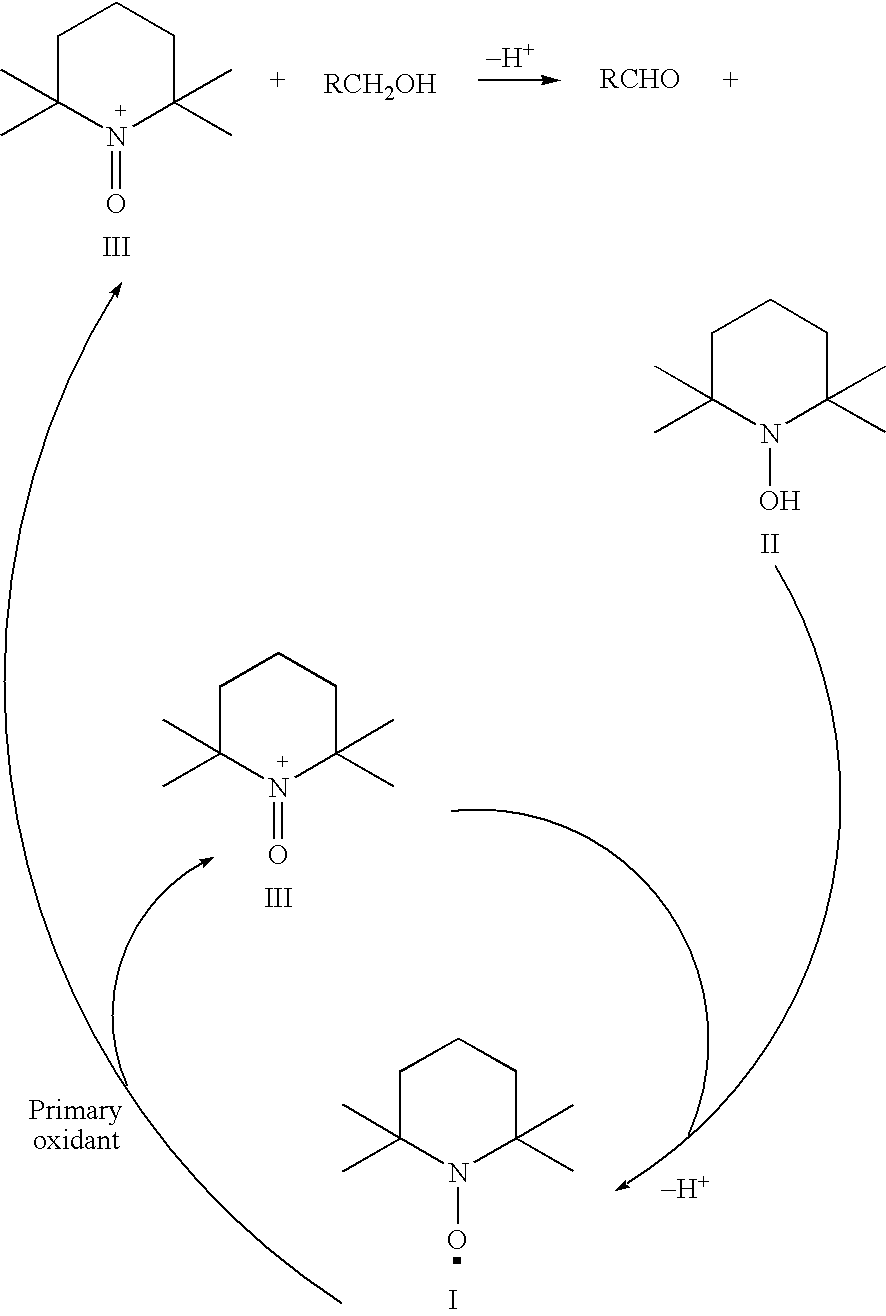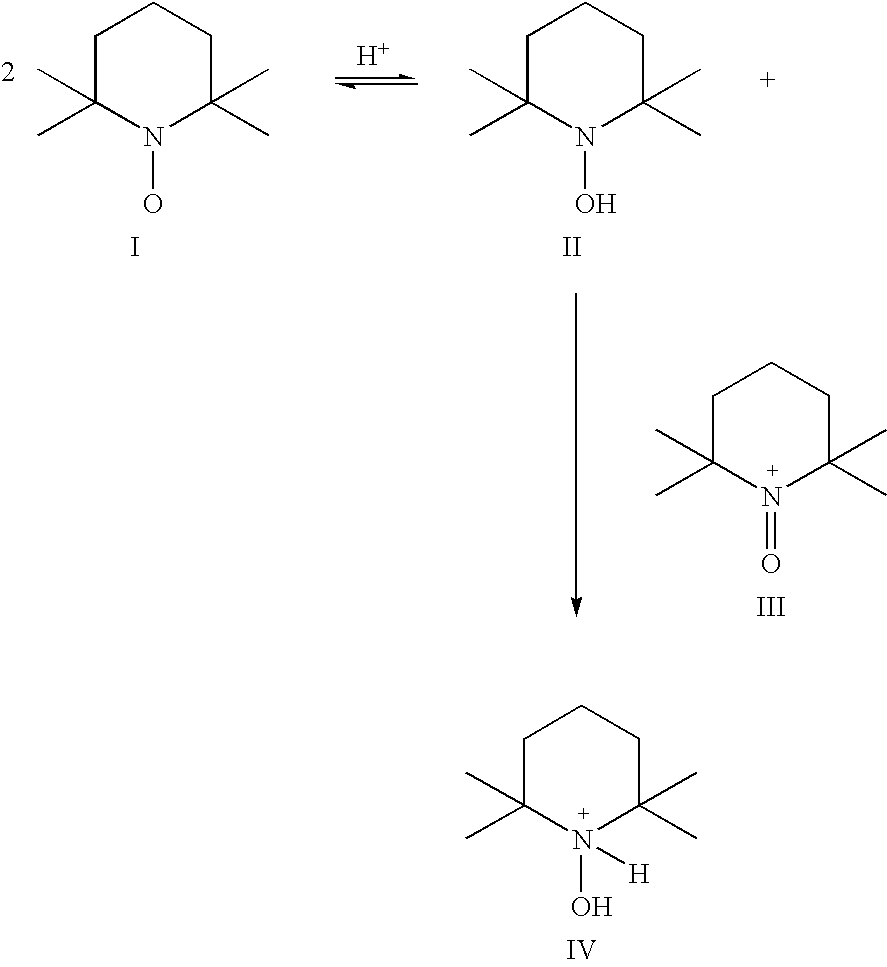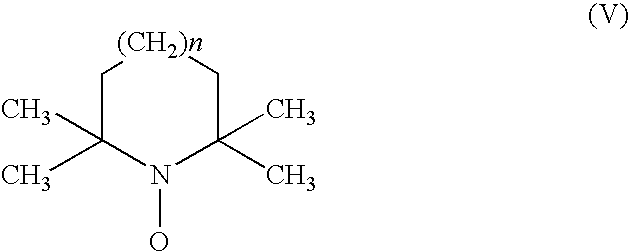Process for the oxidation of hydroxy compounds by means of nitroxy compounds
a technology of nitroxy compounds and hydroxy compounds, which is applied in the field of nitroxy compound oxidation process, can solve the problems of high cost, inability to meet the requirements of economic processes, and often partial loss of nitroxy compounds during oxidation
- Summary
- Abstract
- Description
- Claims
- Application Information
AI Technical Summary
Benefits of technology
Problems solved by technology
Method used
Image
Examples
example 1
[0070] 440 mg (2.8 mmol) TEMPO were dissolved in 10 ml of water. To this mixture, 240 mg ascorbic acid (1.36 mmol) were added in order to reduce TEMPO to the corresponding hydroxylamine. An immediate reaction took place, which could be monitored by the decrease in color after a few minutes. The mixture was allowed to react for 60 minutes and became orange-brown. After lowering the pH to approximately 4 by the addition of diluted HCl, the color disappeared. Subsequently, 200 μl of a sodium hypochlorite solution (1.8M) in water were added. This resulted in an immediate increase and change of the color. This was repeated four times. After addition of altogether 1 ml 1.8M-sodium hypochlorite solution, no further change was observed. By means of UV-vis spectroscopy it was confirmed that the hydroxylamine was completely converted to the nitrosonium ion.
[0071] This experiment proves that it is possible to convert the hydroxylamine directly into the corresponding nitrosonium ion under suit...
example 2
[0072] 1.10 g TEMPO (7.05 mmol) was dissolved in 18 ml 0.5M HC1. Upon heating for 10 minutes at 40° C. the material completely dissolved and an orange-brownish solution was obtained. The material was cooled to room temperature and added to neutralized hypochlorous acid / hypochlorite solution (2.5 mmol at pH 7.5) During the reaction the pH was kept between 4 and 7. A UV-Vis spectrum of the diluted solution showed a λmax value at about 460 to 480 nm, which is characteristic for nitrosonium compounds.
[0073] The mixture was added to a solution of 15 g pulp (Grapho Celeste) in 1.51 water. The pH was adjusted to 6.3. An immediate decrease in pH was observed, due to reaction of the nitrosonium ion and cellulose. To maintain the pH between 6.5 and 7.5, sodium hydroxide had to be added (in total 8.5 mmol NaOH). After the reaction, the pulp was washed repeatedly with water to remove TEMPO and salt. In the modified pulp the aldehyde content was determined by titration with hydroxylamine (see M...
example 3
[0074] 640 mg of TEMPO was suspended in 10 ml 0.25 M hydrochloric acid. A solution of hypochlorous acid was prepared by diluting 1.5 ml 1.8 M hypochlorite to 10 ml and adjusting the diluted solution with 10% acetic acid solution to pH 4.5. To this acidified solution the TEMPO-solution was added. A gradual decrease in pH occurred. To maintain the pH between 3.5 and 5.8 ml 0.5M NaOH was added. The final pH was 4.5. The solution thus obtained was added to a suspension of 5 g pulp in 11 water. The nitrosonium ion was allowed to react with the pulp. An immediate drop of pH occurred. To keep the pH between 6 and 7, 2.0 ml NaOH (0.5M) had to be added during the reaction. After 2 hours, no further pH drop was observed, which indicated that the reaction was completed. The pulp was filtered off and repeatedly washed with water, until the filtrate was colorless. The amount of aldehyde groups formed was 150 pmol / g.
PUM
| Property | Measurement | Unit |
|---|---|---|
| pH | aaaaa | aaaaa |
| temperature | aaaaa | aaaaa |
| temperature | aaaaa | aaaaa |
Abstract
Description
Claims
Application Information
 Login to View More
Login to View More - R&D
- Intellectual Property
- Life Sciences
- Materials
- Tech Scout
- Unparalleled Data Quality
- Higher Quality Content
- 60% Fewer Hallucinations
Browse by: Latest US Patents, China's latest patents, Technical Efficacy Thesaurus, Application Domain, Technology Topic, Popular Technical Reports.
© 2025 PatSnap. All rights reserved.Legal|Privacy policy|Modern Slavery Act Transparency Statement|Sitemap|About US| Contact US: help@patsnap.com



